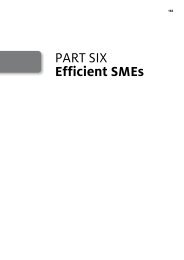- Page 1 and 2: i THIRTEENTH EDITION THE GROWING BU
- Page 3 and 4: iii The perfect property for your
- Page 5 and 6: v Contents Part One Planning for gr
- Page 7 and 8: Contents vii Patenting costs 49 Wha
- Page 9 and 10: Contents ix Part Four People and pe
- Page 11 and 12: Contents xi 6.3 How to find your id
- Page 13 and 14: Contents xiii 9.3 Licensing 233 Ton
- Page 15 and 16: Part One Planning for growth 1
- Page 17 and 18: 3 Business models and competitive a
- Page 19 and 20: Business models and competitive adv
- Page 21 and 22: Business models and competitive adv
- Page 23 and 24: Take a look at the map of our campu
- Page 25 and 26: 11 How to compete against fastmovin
- Page 27 and 28: How to compete against fast-moving,
- Page 29 and 30: How to compete against fast-moving,
- Page 31 and 32: 17 How to build a growth plan 1.3 A
- Page 33 and 34: How to build a growth plan 19 Next
- Page 35: How to build a growth plan 21 Opera
- Page 39 and 40: The SME economic outlook 25 ●●
- Page 41 and 42: 27 The growth opportunity 1.5 Manuf
- Page 43 and 44: The growth opportunity 29 To make t
- Page 45 and 46: 31 Managing setbacks and turnaround
- Page 47 and 48: Managing setbacks and turnarounds 3
- Page 49 and 50: Managing setbacks and turnarounds 3
- Page 51 and 52: Part Two Ideas and innovation 37
- Page 53 and 54: 39 Whole company innovation 2.1 Inn
- Page 55 and 56: Whole company innovation 41 of a pr
- Page 57 and 58: Whole company innovation 43 create
- Page 59 and 60: Whole company innovation 45 Incenti
- Page 61 and 62: 47 Innovating out of recession 2.2
- Page 63 and 64: Innovating out of recession 49 expe
- Page 65 and 66: Innovating out of recession 51 Jacq
- Page 67 and 68: 53 Exploring patent information 2.3
- Page 69 and 70: Exploring patent information 55 ●
- Page 71 and 72: Exploring patent information 57 Mr
- Page 73 and 74: 59 IP challenges for technology ven
- Page 75 and 76: IP challenges for technology ventur
- Page 77 and 78: IP challenges for technology ventur
- Page 79 and 80: 65 Making open innovation work 2.5
- Page 81 and 82: Making open innovation work 67 the
- Page 83 and 84: Making open innovation work 69 an i
- Page 85 and 86: Part Three Gaining market share 71
- Page 87 and 88:
73 Taking your brand to the next le
- Page 89 and 90:
Taking your brand to the next level
- Page 91 and 92:
77 With over 1,000 titles in printe
- Page 93 and 94:
79 Market intelligence 3.2 Nick Hag
- Page 95 and 96:
Market intelligence 81 table 3.2.1
- Page 97 and 98:
Market intelligence 83 but also tha
- Page 99 and 100:
85 Web marketing 3.3 What’s the p
- Page 101 and 102:
Web marketing 87 considerable amoun
- Page 103 and 104:
89 Winning new business 3.4 In a do
- Page 105 and 106:
Winning new business 91 back away),
- Page 107 and 108:
93 Brand rights 3.5 Name? Logo? Dom
- Page 109 and 110:
Brand rights 95 trade mark attorney
- Page 111 and 112:
97 With over 42 years of publishing
- Page 113 and 114:
99 Fit for market 3.6 Confidence is
- Page 115 and 116:
Fit for market 101 markets abroad a
- Page 117 and 118:
Part Four People and performance 10
- Page 119 and 120:
105 Rewarding good performance and
- Page 121 and 122:
Rewarding good performance, lowerin
- Page 123 and 124:
109 With over 1,000 titles in print
- Page 125 and 126:
111 Employment policies 4.2 Belinda
- Page 127 and 128:
Employment policies 113 information
- Page 129 and 130:
Employment policies 115 Belinda Cop
- Page 131 and 132:
117 Taking on an employee 4.3 Help
- Page 133 and 134:
Taking on an employee 119 employee
- Page 135 and 136:
121 The sharpest minds need the fin
- Page 137 and 138:
123 Training for growth 4.4 David G
- Page 139 and 140:
Training for growth 125 of the trai
- Page 141 and 142:
127 With over 1,000 titles in print
- Page 143 and 144:
129 Executive search for smaller bu
- Page 145 and 146:
Executive search for smaller busine
- Page 147 and 148:
133 Improving workplace performance
- Page 149 and 150:
Improving workplace performance 135
- Page 151 and 152:
Part Five Cash flow and working cap
- Page 153 and 154:
139 ÒThe message is clear - we wan
- Page 155 and 156:
141 Cash flow management: an essent
- Page 157 and 158:
Cash flow management 143 3 Keep a c
- Page 159 and 160:
145 With over 42 years of publishin
- Page 161 and 162:
147 Invoice finance for growth 5.2
- Page 163 and 164:
Invoice finance for growth 149 the
- Page 165 and 166:
Invoice finance for growth 151 ●
- Page 167 and 168:
153 Preventing slow payments 5.3 Do
- Page 169 and 170:
Preventing slow payments 155 some l
- Page 171 and 172:
Preventing slow payments 157 Graydo
- Page 173 and 174:
159 Commercial fraud and business i
- Page 175 and 176:
Commercial fraud and business ident
- Page 177 and 178:
Part Six Efficient SMEs 163
- Page 179 and 180:
165 Build the network 6.1 As you gr
- Page 181 and 182:
Build the network 167 essential net
- Page 183 and 184:
169 The sharpest minds need the fin
- Page 185 and 186:
171 Strategic sourcing 6.2 Plan to
- Page 187 and 188:
Strategic sourcing 173 So, how and
- Page 189 and 190:
175 How to find your ideal office 6
- Page 191 and 192:
How to find your ideal office 177 a
- Page 193 and 194:
Part Seven Leading growth 179
- Page 195 and 196:
181 How small business owners can b
- Page 197 and 198:
How small business owners become be
- Page 199 and 200:
How small business owners become be
- Page 201 and 202:
187 Developing the next layer of ma
- Page 203 and 204:
Developing the next layer of manage
- Page 205 and 206:
191 The leadership process 7.3 With
- Page 207 and 208:
The leadership process 193 Although
- Page 209 and 210:
195 With over 1,000 titles in print
- Page 211 and 212:
197 Ethics and the growing company
- Page 213 and 214:
Ethics and the growing company 199
- Page 215 and 216:
Ethics and the growing company 201
- Page 217 and 218:
Part Eight International expansion
- Page 219 and 220:
205 Competing and collaborating wit
- Page 221 and 222:
Competing and collaborating with Ch
- Page 223 and 224:
Competing and collaborating with Ch
- Page 225 and 226:
Competing and collaborating with Ch
- Page 227 and 228:
213 International expansion made ea
- Page 229 and 230:
International expansion made easy 2
- Page 231 and 232:
217 The export challenge 8.3 As a g
- Page 233 and 234:
The export challenge 219 Market Acc
- Page 235 and 236:
Part Nine Structures for growth 221
- Page 237 and 238:
223 Partnerships and collaborations
- Page 239 and 240:
Partnerships and collaborations 225
- Page 241 and 242:
Partnerships and collaborations 227
- Page 243 and 244:
229 Acquisitions that work 9.2 Stra
- Page 245 and 246:
Acquisitions that work 231 Issue 4
- Page 247 and 248:
233 Licensing 9.3 In finding the be
- Page 249 and 250:
Licensing 235 ●● ●● ●●
- Page 251 and 252:
237 With over 42 years of publishin
- Page 253 and 254:
239 Preparing a business for sale 9
- Page 255 and 256:
Preparing a business for sale 241 g
- Page 257 and 258:
Preparing a business for sale 243 L
- Page 259 and 260:
Preparing a business for sale 245 C
- Page 261 and 262:
Part Ten Growth capital 247
- Page 263 and 264:
249 Funding your business through t
- Page 265 and 266:
Funding your business through the r
- Page 267 and 268:
253 The sharpest minds need the fin
- Page 269 and 270:
255 Structured finance 10.2 Structu
- Page 271 and 272:
Structured finance 257 Factoring or
- Page 273 and 274:
259 Transforming the finance functi
- Page 275 and 276:
Transforming the finance function 2
- Page 277 and 278:
Transforming the finance function 2
- Page 279 and 280:
265 Index of advertisers A.Steele A








